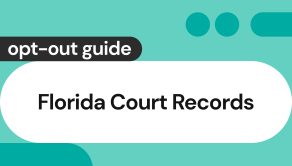Combat cyberstalking: essential prevention tips for 2025

According to Pew Research Center, 41% of U.S. adults have experienced online harassment in 2020, and 25% have been victims of severe forms of harassment such as cyberstalking, sexual harassment, or physical threats. While these numbers alone are startling, they also support an alarming trend that online abuse like cyberstalking is becoming more prevalent and severe. Can anything be done to stop it?
What is cyberstalking?
The National Institute of Justice’s (NIJ) cyberstalking definition involves “repeated use of electronic communications to stalk a person or group.” Like many other investigative government entities, the NIJ categorizes cyberstalking as one of many forms of digital abuse. It’s no wonder why. Cyberstalking is often an escalation or component of a broader online harassment campaign. For instance, if your cyberbully escalates to tracking and abusing you across multiple accounts and means of communication, then they’re now engaged in cyberstalking (meaning a repeated and deliberate attempt to harass or intimidate you on multiple accounts across the internet).
According to Dr. Nuccitelli, a cyberpsychology researcher, online safety educator, and creator of a cyberspace concept called iPredator, cyberbullies, cyberstalkers, cyber harassers, cybercriminals, online child predators, online child pornography consumers, internet trolls or cyberterrorists—all fall within the scope of iPredator.
Dr. Nuccitelli uses the following criteria to define this modern kind of predation: “I. A self-awareness of causing harm to others, directly or indirectly, using information and communications technology. II. The use of information and communications technology to obtain, tamper with, exchange and deliver destructive information. III. A general understanding of cyberstealth (aka, digital cloaking) to engage in criminal or deviant activities or to profile, locate, stalk and attack a target.”
Most importantly, cyberstalking is not just a criminal offence. It can cause severe emotional distress. When you’re targeted by a cyberstalker, it’s common to be afraid, embarrassed, and confused. This could lead to anxiety and depression, and in some significant cases, trauma or suicidal ideation. Remember that there’s always someone who can help you. If you need support, reach out to a crisis line or mental health professional.
Cyberstalking statistics
Cyberstalking doesn’t get as much attention as other forms of cybercrime, like data breaches and identity theft. However, as it continues to affect more people every year, we’re starting to see more researchers set their sights on cyberstalking. Here are some of the most startling cyberstalking statistics in the literature:
Women are more likely to be targeted
Pew Research has been studying online harassment for years. Among many other forms of digital abuse, they track cyberstalking statistics. According to their 2020 report, 13% of women were reportedly victims of cyberstalking.
Young women were particularly at risk, and sexual harassment was a common component of their stalking. Comparatively, 9% of men in the same study reported that they were victims of cyberstalking. This continues a multi-year trend of women being more frequently targeted than men.
Divorced or separated individuals are at higher risk
According to a research report by the Bureau of Justice Statistics (BJS), individuals who were divorced or separated were more likely to experience stalking than those who were married, never married, or widowed. One interpretation of this is that ex-lovers may be more compelled to engage in stalking due to the intense emotions around separations.
Due to their proximity in a previous relationship, it’s also likely that recently separated people still have access to some of their ex-lover’s accounts or information. This may make it easier for separated people to engage in stalking than strangers.
Cyberstalking rates have jumped over 50% since 2017
According to the online harassment report by Pew Research, cyberstalking rates have risen over 50% from 2017 to 2020. While in 2017, 7% of U.S. adults said they experienced cyberstalking, in 2020, that number rose to 11%. Unfortunately, there’s no reason to think that online stalking is slowing down.

Portrait of a cyberstalker: behind the crime
Stalking involves prolonged, deliberate, and targeted harassment. There’s normally some sort of motive — such as an ex-employee, ex-lover, or jealous stranger getting revenge for a perceived wrongdoing. Some research even suggests that stalkers don’t primarily enjoy their actions. Rather, they’re compelled by intense emotions like frustration or anger to stalk their victims. In this way, cyberstalking is a crime that seems to result more from obsession than pure criminal intent. Unfortunately, that doesn’t make it any less dangerous.
In fact, one highlight of the psychology of cyberstalkers is their tendency to offend in real life as well as online. This makes cyberstalking a particularly worrisome crime to fall victim to. After all, the victim can never know for sure if their stalker will take things offline. This makes cyberstalking unique from other types of cyber harassment — like trolling, which also involves disruptive online behaviors, except trolls typically don’t need a reason to harass others. It’s just something to do. For cyberstalkers, it’s more like a lifestyle.
Examples of cyberstalking
Cyberstalking can happen just about anywhere on the internet, but it commonly occurs on social media accounts, messengers, message boards, email, and phone calls. Here are some examples of things cyberstalkers are likely to do:
- Spread false accusations and heinous rumors about you
- Post highly offensive statements and comments
- Repeatedly send controlling, intimidating, or dirty emails or messages
- Closely monitor your location and online activities
- Constantly interact with your posts, leaving a massive trail of likes and comments
- Target you with malicious programs to hack or hijack your online accounts
- Steal your identity
- Use catfishing to lure you into a false relationship and exploit your finances
- Create fake accounts to counteract your privacy settings
- Post or circulate real or fake photos of you
- Try to get your sexually explicit photos or attack you with their own explicit images
- Locate sensitive or confidential information and blackmail you with its exposure
Prevent cyberstalking with these tips
Keeping your online activities secure in the modern world has to include cyberstalking prevention. Thankfully, many of the most important cyberstalking prevention tips overlap with other common approaches to digital hygiene, privacy protection, and cybersecurity best practices.
- Lock down your accounts: Make a list of your most important accounts (especially social media) and go through each one to make sure you’re using strong privacy settings. Ideally, your accounts are set to private, no one can “tag” you without your approval, you’re using strong passwords with two-factor authentication, and you never overshare.
- Guard your location: If you’re out and about, make sure you never share your location in real-time to avoid unwanted contact with a stalker. Even after you’re home, be cautious about posting any content that might tip others off to your location. Even if you’re careful, popular social media features like location tagging may unintentionally give away your exact location. Consider turning these features off.
- Keep your devices safe: Make sure all of your devices have a locking mechanism enabled. This could be a fingerprint, facial recognition lock, password, or PIN — as long as it keeps others out. Also, make sure you know where your devices are in public or at work. Leaving your device unattended for even a few minutes will give stalkers enough time to access your information or download trackers.
- Be very cautious on dating services: Dating apps and websites are notoriously risky if you aren’t taking steps to protect your identity. Make sure you never give out your personal information, address, contact information, or social media accounts unless you’ve already met the person and consider them trustworthy.
- Take defensive measures if you’re leaving a relationship: If you’re about to or have recently ended a relationship, it’s important to bolster your account security. Change all of your passwords, enable two-factor authentication, and consider setting your accounts to private. If you’re coming out of a troubled relationship, you might want to consider getting a new phone and blocking or unfriending your ex-partner.
Get control over your digital footprint
If you want to prevent cyberstalking, controlling your online presence is essential. Data brokers and people-search sites are the biggest threats, collecting your data and publishing it for the world to see. If you search for your name on Google, it probably won’t take too much scrolling before you find your personal information listed on these websites. As you can imagine, this is exactly what a cyberstalker wants to find: age, address, phone number, email address, social media accounts, family relationships, and plenty more.
You can remove your data from these websites, but you’ll quickly discover that they don’t want to make it easy for you. To make matters worse, you could find your information on more than 100 of them. We’ve created free removal instructions to help you opt-out of these websites. If that becomes too tedious (the process is cumbersome, time-consuming, and unique to each site), you can use Onerep to automatically opt out. Our tool will also continuously monitor 232 sites to make sure your information doesn’t resurface.
How to stop cyberstalking
While being targeted by a cyberstalker can be scary, remember that you have the power to stop it. By acting quickly and following these steps, you can get your life back and be safer from cyberstalking in the future:
1. Document everything
Harmful cyberstalking activities are against the terms of service for all major social media platforms. That means that your cyberstalker’s activities may be taken down at any moment. Make sure you snap pictures as evidence in case things escalate — but never prod them on.
2. Don’t respond to a stalker
If you’re being harassed by a cyberstalker, ask them to stop one time. If they refuse, do not send mean messages, stoop to their level, or otherwise stoke the flames. Ignore them, report them, block them, and then secure your accounts.
3. Report cyberstalking
Once you’ve collected evidence, you can report the cyberstalker to your social media platform. If their activities are serious enough, you can also file a report with your local police department, as we’ll discuss in the next section.
4. Block them
Once you’ve collected evidence and filed a report, there’s no reason to let your cyberstalker keep contacting you. Go ahead and block the stalker, and be very vigilant about new friend requests afterward — they may resort to catfishing.
5. Change all passwords
Cyberstalking is sometimes committed by people you know or used to know, such as ex-lovers. Just to be safe, make sure you change your passwords to long, randomized strings of letters, numbers, and special characters. This will protect your accounts from being compromised by those who once had access to them.
6. Alert friends, family, and colleagues
Sometimes, stalkers target people associated with their victims. It’s important to let people in your social sphere know that you’ve become a victim of cyberstalking. They can keep an eye out for suspicious activities, and they can be a great support network for you when you need it most.
7. Bolster offline security
Keep in mind that it isn’t uncommon for cyberstalking to move into offline stalking. While you shouldn’t scare yourself or become too paranoid, it’s worth re-evaluating your home security.
How to report cyberstalking
One of the most effective responses to a cyberstalker is reporting them. While it might not end their obsession, it can make it a lot harder for them to harass you. Here’s how to report your cyberstalker to social media platforms, law enforcement, and even legal entities.
Reporting your cyberstalker to social media platforms
Social media platforms have terms of service which, if violated, can lead to punitive measures. If your abuser is engaged in visible cyberstalking behaviors, such as persistent threatening messages, catfishing, or filling your messages with obscene pictures, then reporting them to your social media platform should result in some form of response. Once you’ve documented their behavior, you can also block them.
Reporting cyberstalking to the police
We mentioned earlier how important it is to document your cyberstalker’s activities. This will make it much easier to file a report with law enforcement. More than that, if you have proof that a cyberstalker poses a significant threat to your livelihood, the police are much more likely to take action. Even if they cannot respond immediately, it’s always a good idea to have an official paper trail.
Consider taking legal action
There are no federal laws against cyberstalking by name, but there are many ways to prosecute the activities of a cyberstalker. For instance, if your cyberstalker has left you concerned for your life or health, there are grounds to take legal action against them. Death threats or other threats involving bodily harm can be used as evidence in these cases.
Likewise, if your cyberstalker’s abuse included identity theft, fraud, financial crimes, or nonconsensual explicit imagery, you also have grounds for legal action. As for state cyberstalking laws, these vary quite a bit, so it’s always a good idea to get legal counsel for your particular case.
Conclusion
Cyberstalking has become a significant threat for everyone on the internet, but by taking steps to protect your privacy, you can enjoy the best parts of the internet — without worrying about online ne’er-do-wells. Onerep’s privacy protection tool makes it easy to keep your information out of the wrong hands.
FAQ
How can cyberstalking affect the victim?
Cyberstalking can have significant consequences for its victims, including paranoia, fear for one’s own health, reputation damage, humiliation, and severe stress.
How is cyberstalking different from traditional stalking?
Cyberstalking concerns digital stalking behaviors. However, a traditional stalker can also be a cyberstalker if they conduct some of their activities online.
Is cyberstalking illegal?
While there isn’t an explicit federal law against cyberstalking, the crimes that cyberstalkers often commit can be prosecuted. Some states have passed cyberstalking laws — seek legal counsel on this matter.
How can I prove cyberstalking?
Document everything. At any moment, social media platforms could remove the cyberstalking posts or messages due to a violation of their policies. Make sure you have records.
Can I sue for cyberstalking?
Seek legal counsel for your particular case, but understand that cyberstalking is often taken seriously. The crimes that cyberstalkers commit are sometimes seen as precursors to real-world violence. If you can prove damages, this could result in a successful case.





Mark comes from a strong background in the identity theft protection and consumer credit world, having spent 4 years at Experian, including working on FreeCreditReport and ProtectMyID. He is frequently featured on various media outlets, including MarketWatch, Yahoo News, WTVC, CBS News, and others.